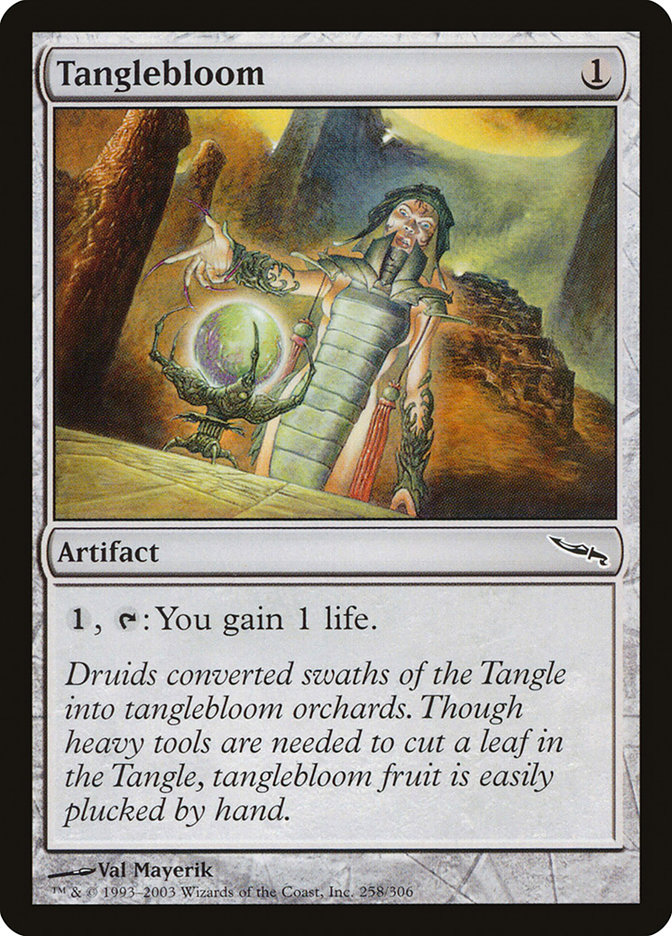Emaranhadina Carta MTG
| Expansões | Lançada em 3 expansõesVer todas |
| Custo de mana | |
| Custo convertido de mana | 1 |
| Raridade | Comum |
| Tipo | Artefato |
Texto da carta
{1}, {T}: Você ganha 1 ponto de vida.
Os druidas converteram searas do Emaranhado em pomares de emaranhadina. Embora sejam necessárias ferramentas pesadas para se cortar uma folha do Emaranhado, o fruto de emaranhadina é fácil de colher com a mão.
Texto da carta Emaranhadina
{1}, {T}: Você ganha 1 ponto de vida.
Os druidas converteram searas do Emaranhado em pomares de emaranhadina. Embora sejam necessárias ferramentas pesadas para se cortar uma folha do Emaranhado, o fruto de emaranhadina é fácil de colher com a mão.
Onde comprar
Se você deseja comprar um cartão Emaranhadina MTG de um conjunto específico como Mirrodin and Ninth Edition, há diversas opções confiáveis a serem consideradas. Uma das principais fontes é a loja de jogos local, onde muitas vezes você pode encontrar boosters, cartas individuais e decks pré-construídos de conjuntos atuais e de alguns conjuntos anteriores. Eles geralmente oferecem o benefício adicional de uma comunidade onde você pode negociar com outros jogadores.
Para um inventário mais amplo, especialmente de conjuntos mais antigos, mercados on-line como TCGPlayer, Card Kingdom e Card Market oferecem seleções extensas e permitem que você pesquise cartas de conjuntos específicos. Grandes plataformas de comércio eletrônico, como eBay e Amazon, também têm listagens de vários vendedores, o que pode ser um bom lugar para procurar produtos lacrados e achados raros.
Além disso, o site oficial do Magic geralmente tem um localizador de lojas e listas de varejistas para encontrar a Wizards of the Produtos licenciados pela Costa. Lembre-se de verificar a autenticidade e a condição dos cartões ao comprar, especialmente de vendedores individuais em mercados maiores.
Abaixo está uma lista de alguns sites de lojas onde você pode comprar os Emaranhadina e outras cartas MTG:
 COMPRAR
COMPRAR BurnMana é parceiro oficial da TCGPlayer
- eBay
- Card Kingdom
- Card Market
- Star City Games
- CoolStuffInc
- MTG Mint Card
- Hareruya
- Troll and Toad
- ABU Games
- Card Hoarder Magic Online
- MTGO Traders Magic Online
Veja produtos de MTG
Expansões
A carta Emaranhadina Magic the Gathering foi lançada em 2 expansões diferentes entre 2003-10-02 e 2005-07-29. Ilustrado por Val Mayerik.
| # | Lançamento | Nome | Código | Símbolo | Número | Moldura | Layout | Borda | Artista |
|---|---|---|---|---|---|---|---|---|---|
| 1 | 2003-10-02 | Mirrodin | MRD | 258 | 2003 | Normal | Preta | Val Mayerik | |
| 2 | 2005-07-29 | Ninth Edition | 9ED | 311 | 2003 | Normal | Branca | Val Mayerik | |
| 3 | 2005-07-29 | Ninth Edition | 9ED | 311★ | 2003 | Normal | Preta | Val Mayerik |
Legalidades
Magic the Gathering formats where Emaranhadina has restrictions
| Formato | Legalidade |
|---|---|
| Commander | Válida |
| Legacy | Válida |
| Paupercommander | Válida |
| Modern | Válida |
| Oathbreaker | Válida |
| Pauper | Válida |
| Vintage | Válida |
| Duel | Válida |
| Predh | Válida |
| Penny | Válida |


